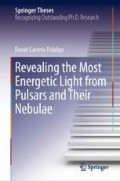Abstract
Pulsar wind nebulae (pwne) constitute the most numerous TeV gamma-ray sources in our galaxy. Most of the 19 firmly identified pulsar wind nebulae to date were spotted in the h.e.s.s. Galactic Plane Survey (hgps, [1]) from the Southern Hemisphere, but also magic and veritas contributed to this population with the discoveries of 3c 58 and ct1 towards the outer part of the Milky Way [2, 3]. TeV pulsar wind nebulae are usually located close to a Galactic spiral arm structure, where the dense environment provides a natural birth place for pulsars. In particular, the Scutum-Centaurus arm near the Galactic center hosts almost half of the current TeV pwne population [4]. To increase the population with members situated in the outer part of our galaxy, magic selected and observed 6 young and energetic gamma-ray pulsars that could potentially power TeV pulsar wind nebulae [5].
We find clear evidence that pulsars with large spin-down energy flux are associated with VHE \(\gamma \) -ray sources.
The h.e.s.s. Collaboration, 2007
Access this chapter
Tax calculation will be finalised at checkout
Purchases are for personal use only
Notes
- 1.
https://www.mpi-hd.mpg.de/hfm/HESS/hgps/, last accessed 10/04/2018.
- 2.
References
Abdalla H et al (2018a) The H.E.S.S. Galactic plane survey. Astron Astrophy 612:A1. https://doi.org/10.1051/0004-6361/201732098
Aleksić J et al (2014b) Discovery of TeV \(\gamma \)-ray emission from the pulsar wind nebula 3C 58 by MAGIC. Astron Astrophy 567:L8. https://doi.org/10.1051/0004-6361/201424261
Aliu E et al (2013) Discovery of TeV gamma-ray emission from CTA 1 by VERITAS. Astrophys J 764(1):38. https://doi.org/10.1088/0004-637X/764/1/38
Abdalla H et al (2018b) The population of TeV pulsar wind nebulae in the H.E.S.S. Galactic Plane Survey. Astron Astrophys 612:A2. https://doi.org/10.1051/0004-6361/201629377
magic Collaboration et al (2018) MAGIC observations on Pulsar Wind Nebulae around high spin-down power Fermi-LAT pulsars. In preparation
Zepka A et al (1996) Discovery of three radio pulsars from an X-ray-selected sample. Astrophys J 456:305. https://doi.org/10.1086/176651
Giacconi R et al (1979) The Einstein /HEAO 2/ X-ray observatory. Astrophys J 230:540. https://doi.org/10.1086/157110
Taylor JH, Cordes JM (1993) Pulsar distances and the galactic distribution of free electrons. Astrophys J 411:674. https://doi.org/10.1086/172870
Cordes JM, Lazio TJW (2002) NE2001.I. A new model for the Galactic distribution of free electrons and its fluctuations
Yao JM et al (2017) A new electron-density model for estimation of pulsar and FRB distances. Astrophys J 835(1):29. https://doi.org/10.3847/1538-4357/835/1/29
Manchester RN et al (2005) The Australia telescope national facility pulsar catalogue. Astrophys J 129(4):1993–2006. https://doi.org/10.1086/428488
Yuan JP et al (2010) 29 glitches detected at Urumqi observatory. Mon Not R Astron Soc 354(1):811. https://doi.org/10.1111/j.1365-2966.2010.16272.x
Teixeira MM et al (2016) Investigations of the emission geometry of the four-component radio pulsar J0631+1036. Mon Not R Astron Soc 455(3):3201–3206. https://doi.org/10.1093/mnras/stv2520
Abdo AA et al (2013) The second Fermi large area telescope catalog of gamma-ray pulsars. Astrophys J Suppl Ser 208(2):17. https://doi.org/10.1088/0067-0049/208/2/17
Trümper J (1982) The ROSAT mission. Adv Space Res 2(4):241–249. https://doi.org/10.1016/0273-1177(82)90070-9
Torii K et al (2001) ASCA detection of pulsed X-ray emission from PSR J0631+1036. Astrophys J 551(2):L151–L154. https://doi.org/10.1086/320016
Tanaka Y et al (1994) The X-ray astronomy satallite ASCA. PASJ 46:L37–L41
Kennea J et al (2002) XMM-Newton sets the record straight: no X-ray emission detected from PSR J0631+1036
Aschenbach B (2002) In-orbit performance of the XMM-Newton x-ray telescopes: images and spectra, p 8. https://doi.org/10.1117/12.454367
Weltevrede P et al (2010) Gamma-ray and radio properties of six pulsars detected by the fermi large area telescope. Astrophys J 708(2):1426–1441. https://doi.org/10.1088/0004-637X/708/2/1426
Mignani RP et al (2016) Observations of three young \(\gamma \)-ray pulsars with the Gran Telescopio Canarias. Mon Not R Astron Soc 461(4):4317–4328. https://doi.org/10.1093/mnras/stw1629
Aharonian F (2005) A new population of very high energy gamma-ray sources in the Milky Way. Science 307(5717):1938–1942. https://doi.org/10.1126/science.1108643
Carrigan S et al (2007) Establishing a connection between high-power pulsars and very-high-energy gamma-ray sources. In: 30th International cosmic ray conference, Meirda, Mexico, pp 659–662
Aliu E et al (2008c) Search for VHE \(\gamma \)-ray emission in the vicinity of selected pulsars of the Northern Sky with VERITAS. In: AIP conference proceedings, pp 324–327. AIP. https://doi.org/10.1063/1.3076672
Abdo AA et al (2009a) Fermi/Large area telescope bright gamma-ray source list. Astrophys J Suppl Ser 183(1):46–66. https://doi.org/10.1088/0067-0049/183/1/46
Abdo AA et al (2009b) Milagro observations of multi-TeV emission from galactic sources in the fermi bright list. Astrophys J 700(2):L127–L131. https://doi.org/10.1088/0004-637X/700/2/L127
Acero F et al (2013) Constraints on the Galactic population of TeV pulsar wind nebulae using fermi large area telescope observations. Astrophys J 773(1):77. https://doi.org/10.1088/0004-637X/773/1/77
Ackermann M et al (2011) Fermi-LAT search for pulsar wind nebulae around gamma-ray pulsars. Astrophys J 726(1):35. https://doi.org/10.1088/0004-637X/726/1/35
Abeysekara AU et al (2017) The 2HWC HAWC observatory gamma-ray catalog. Astrophys J 843(1):40. https://doi.org/10.3847/1538-4357/aa7556
Author information
Authors and Affiliations
Corresponding author
Rights and permissions
Copyright information
© 2019 Springer Nature Switzerland AG
About this chapter
Cite this chapter
Carreto Fidalgo, D. (2019). Does PSR J0631 Power a Pulsar Wind Nebula?. In: Revealing the Most Energetic Light from Pulsars and Their Nebulae. Springer Theses. Springer, Cham. https://doi.org/10.1007/978-3-030-24194-0_8
Download citation
DOI: https://doi.org/10.1007/978-3-030-24194-0_8
Published:
Publisher Name: Springer, Cham
Print ISBN: 978-3-030-24193-3
Online ISBN: 978-3-030-24194-0
eBook Packages: Physics and AstronomyPhysics and Astronomy (R0)

